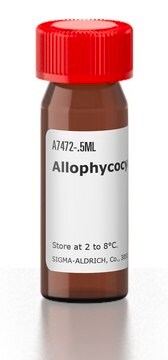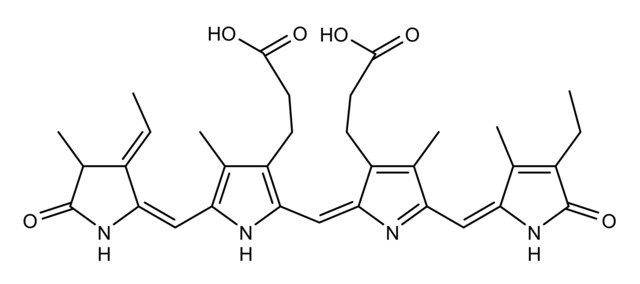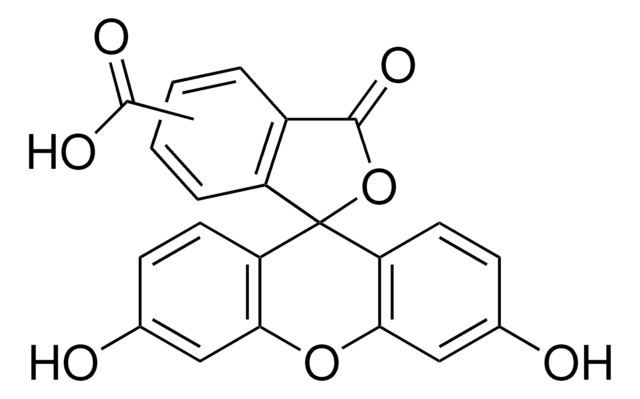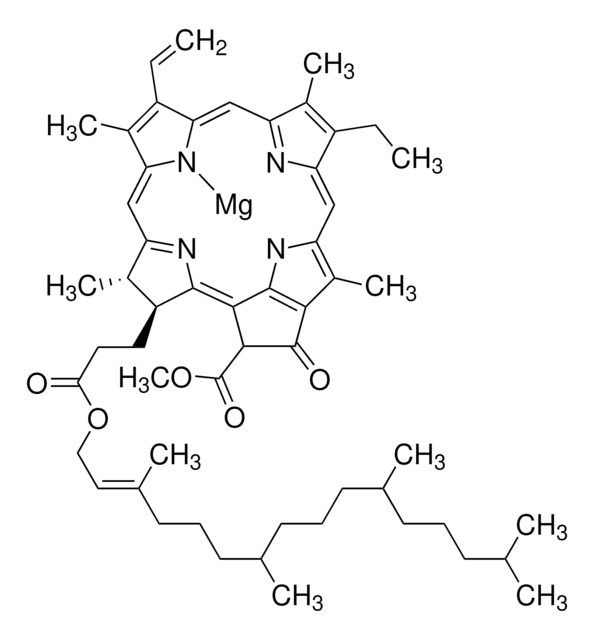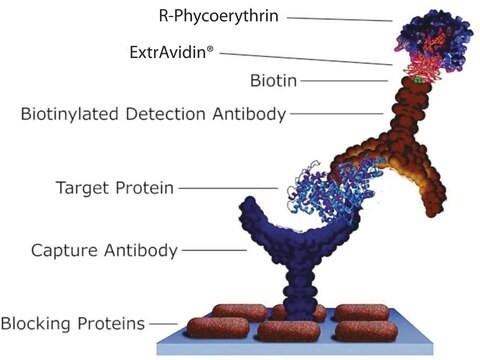52412
R-Phycoerythrin
BioReagent, passes test for gel electrophoresis
Synonyme(s) :
R-PE, phycobiliprotein
Se connecterpour consulter vos tarifs contractuels et ceux de votre entreprise/organisme
About This Item
Produits recommandés
Gamme de produits
BioReagent
Niveau de qualité
Concentration
≥10.0 mg/mL (UV)
Technique(s)
electrophoresis: suitable
Fluorescence
λex 542 nm; λem 575 nm in 0.1 M phosphate pH 7.2
Adéquation
passes test for gel electrophoresis
Température de stockage
2-8°C
Catégories apparentées
Description générale
R-Phycoerythrin or R-PE is a fluorescent probe belonging to the group of phycobiliproteins obtained from macroalgae. R-Phycoerythrin (R-PE) is a protein acting as a photosynthetic accessory pigment in red algae (Rhodophyta). It is an oligomeric protein of 240 kDa, with 6 α (about 20 kDa), 6 β (about 20 kDa), and 1 γ (about 30 kDa) subunits. Phycobiliproteins are water-soluble light-harvesting proteins with a high fluorescent property.
Application
R-Phycoerythrin (R-PE) is useful in the laboratory as a fluorescence-based indicator for the presence of cyanobacteria and a variety of immunofluorescence applications. R-PE is a useful fluoroprobe in various electrophoretic procedures. R-Phycoerythrin (R-PE) proteins detect mercury ions in soil and groundwater samples. Phycoerythrin has been widely used in food, cosmetics, immunodiagnostics, and analytical reagents.
Remarque sur l'analyse
The product is suspended in 150 mM sodium phosphate, 60% ammonium sulfate, 1 mM EDTA, 1 mM sodium azide, pH 7.0 and must be dialyzed against conjugation buffer or PBS before conjugation.A566/A280 >4.6, A620/A566 <0.03, A566/A498 <1.5
Vous ne trouvez pas le bon produit ?
Essayez notre Outil de sélection de produits.
Code de la classe de stockage
12 - Non Combustible Liquids
Classe de danger pour l'eau (WGK)
WGK 1
Point d'éclair (°F)
Not applicable
Point d'éclair (°C)
Not applicable
Équipement de protection individuelle
Eyeshields, Gloves
Faites votre choix parmi les versions les plus récentes :
Déjà en possession de ce produit ?
Retrouvez la documentation relative aux produits que vous avez récemment achetés dans la Bibliothèque de documents.
Les clients ont également consulté
Xuefei Sun et al.
Journal of chromatography. A, 1216(1), 159-164 (2008-12-17)
Electric field gradient focusing (EFGF) is a technique used to simultaneously separate and concentrate biomacromolecules, such as proteins, based on the opposing forces of an electric field gradient and a hydrodynamic flow. Recently, we reported EFGF devices fabricated completely from
Joerg Martini et al.
Lab on a chip, 12(23), 5057-5062 (2012-10-10)
We describe an optical detection technique that delivers high signal-to-noise discrimination to enable a multi-parameter flow cytometer that combines high performance, robustness, compactness and low cost. The enabling technique is termed "spatially modulated detection" and generates a time-dependent signal as
Kun Tang et al.
Biochimica et biophysica acta, 1817(7), 1030-1036 (2012-04-03)
Phycobilisomes, the light-harvesting antennas in cyanobacteria and red algae, consist of an allophycocyanin core that is attached to the membrane via a core-membrane linker, and rods comprised of phycocyanin and often also phycoerythrin or phycoerythrocyanin. Phycobiliproteins show excellent energy transfer
Radek Sachl et al.
Biophysical journal, 101(11), L60-L62 (2012-01-21)
Even though superresolution microscopy indicates that size of plasma membrane rafts is <20 nm, those structures have never been observed. Förster resonance energy transfer (FRET) is therefore still the most powerful optical method for characterization of such domains. In this letter
David Rizzo et al.
Cytometry. Part B, Clinical cytometry, 84(2), 125-132 (2012-12-12)
Flow cytometry is the reference technique for assessing ZAP70 expression, a marker of poor prognosis in CLL. One of the most common methods is to assess ZAP70 levels in CLL cells by calculating the ratio between ZAP70 mean fluorescence intensities
Notre équipe de scientifiques dispose d'une expérience dans tous les secteurs de la recherche, notamment en sciences de la vie, science des matériaux, synthèse chimique, chromatographie, analyse et dans de nombreux autres domaines..
Contacter notre Service technique
